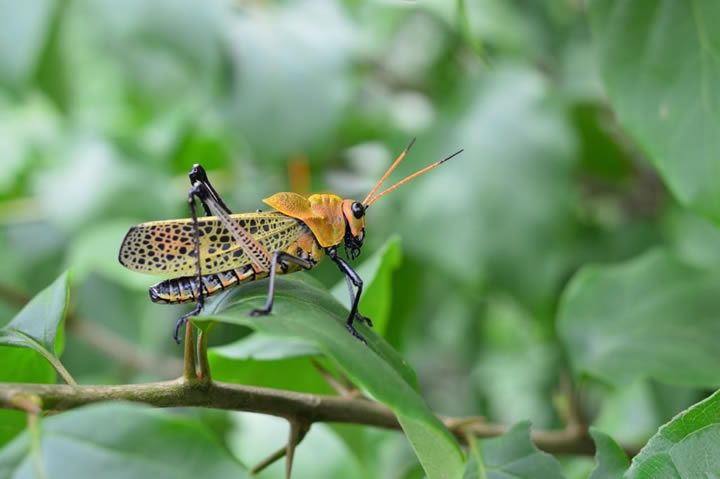The battle against these crop-destroying pests is relentless and proper management requires the knowledge of entomologists, pest control advisors (PCAs), and crop advisors to provide accurate and actionable data.
 Understanding the Significance of Agricultural Insect Management
Understanding the Significance of Agricultural Insect Management

Grady Moore | Farmsense
Agriculture stands at the heart of human civilization as the backbone of global food production, providing nourishment for billions of people daily. Yet, this vital sector faces a litany of challenges that threaten its stability and productivity. Among these challenges, one of — if not the most — persistent and destructive is the damage caused by insects. That’s why we decided to take a step back this month to highlight the significance of agricultural insect management.
Insects, while integral to many ecological processes, pose a formidable threat to crops worldwide. Each year, insects are responsible for destroying up to 40% of global crop yields, according to the Food and Agriculture Organization (FAO). This staggering loss not only undermines food security but also puts immense pressure on farmers and the global food supply chain. The battle against these crop-destroying pests is relentless and proper management requires the knowledge of entomologists, pest control advisors (PCAs), and crop advisors to provide accurate and actionable data, as well as the capability for farmers to revise their agricultural insect management strategy at a moment’s notice.
The field of agricultural insect management is akin to an art form, demanding a blend of scientific knowledge, strategic planning, and hands-on experience. For commercial farmers, mastering this art is crucial and often relies on outside expertise and specialized tools like insect monitoring technology. Effective agricultural insect management in commercial settings can mean the difference between a high-yield harvest and a devastating loss.
The Current State of Agricultural Insect Management
Agricultural insect management today consists of a blend of traditional practices, innovative insect monitoring technology, and the collective knowledgebase of the agriculture community. As farmers work to protect their crops, a variety of control methods are at their disposal, each with unique benefits and considerations. Understanding and choosing the best approach often requires operators to utilize multiple resources and is critical for effective agricultural pest management.
Modern Agricultural Insect Management Control Methods
Chemical Control – Chemical controls are usually the first method that come to mind when discussing agricultural insect management methods in commercial agriculture. Pesticides remain a widely used method around the globe, involving the application of chemicals to target both a broad-spectrum of species or in some cases, a specific species. The United States Geological Survey (USGS) estimates that the annual use of conventional pesticides in the United States is around one billion pounds. While these pesticides, especially those of the broad-spectrum class, can be highly effective, their use must be carefully managed to avoid issues such as pesticide resistance development and environmental harm. Regulatory guidelines and precision application techniques help mitigate these risks, ensuring that pesticides are used safely and effectively.
Biological Control – Biological control methods harness the power of nature, employing natural predators, parasites, and pathogens to keep pest populations in check. Although this eco-friendly approach isn’t typically the first choice for large-scale commercial agriculture operators, it can serve as a supplementary control method to integrated pest management (IPM) strategies. Ideally, a well-established IPM strategy combined with a supplementary biological control method can reduce the need for broad-spectrum pesticide interventions. For instance, introducing beneficial insects like parasitic wasps (parasitoids) can significantly reduce insect populations in a sustainable manner by targeting agricultural pests like aphids, whiteflies, mealybugs, caterpillars, leaf miners, and stink bugs.
Cultural Control – Cultural control involves modifying farming practices to make the environment less hospitable for pests. Techniques such as crop rotation, intercropping, and adjusting planting times may disrupt insect life cycles and reduce their impact. Additionally, maintaining field hygiene through methods like proper soil preparation and sanitation, controlled grazing, and revegetation also helps reduce potential pest habitats.
Physical Control – Physical control includes methods like sticky traps (also known as delta traps), barriers, and manual removal. Once the industry standard for monitoring agricultural insect pest pressure, sticky trap monitoring methods are quickly being replaced with automated insect monitoring technology like FarmSense’s FlightSensor, which uses artificial intelligence, machine learning, and computational entomological models to provide farmers with real-time, actionable insights into insect pests throughout their fields. That said, physical can still be an effective tool to capture flying insects. However, due to their labor-intensive nature, large-scale agricultural operations may find the use of sticky traps to be the equivalent of trying to extinguish a large fire with only a small bucket of water.
Choosing the appropriate agricultural insect control method(s) requires a deep understanding of the specific crop and pest dynamics. Take, for example, the challenge of managing navel orange worms in almond orchards. These pests can cause significant damage, affecting both yield and quality of not only the current season’s harvest, but of future harvests as well. An effective management strategy might combine biological controls, such as introducing natural predators, with cultural practices like properly timed and thorough harvesting to minimize worm infestation. Chemical controls can be applied judiciously to manage severe outbreaks, and automated pest monitoring devices can be implemented to alert farmers to the presence of the adult navel orange worm moth.
By carefully assessing the pest scenario and crop needs, farmers can implement a targeted approach that maximizes effectiveness while minimizing negative impacts. This integrated pest management (IPM) strategy not only helps protect crops but also promotes sustainability, supporting long-term agricultural productivity and environmental health.
How Do Organic Farmers Handle Agricultural Pest Management?
Organic farming practices, as outlined by the US Environmental Protection Agency (EPA), emphasize the use of natural methods over synthetic fertilizers and pesticides. Given the challenges organic farmers face, particularly with insect management, their adaptation to the limited tools available has been nothing short of remarkable. With the global organic farming industry expected to span over 141 million hectares by 2027, organic agriculture and sustainability practices are clearly growing trends. For farmers in this sector, adopting best practices and optimizing operations is crucial.
Effective pest monitoring and management are crucial for success in certified organic farming operations. While the previously discussed conventional farms have a wide array of specialized pesticides at their disposal, organic growers rely on proactive pest monitoring and prevention strategies to achieve sustainable yields and profitability. According to the USDA, measures such as maintaining healthy soil ecology, supporting biodiversity through crop rotations, providing habitats for beneficial species, and reducing pest habitats are essential for preventing problematic insects in organic agricultural environments.
Antiquated insect pest monitoring methods like the aforementioned sticky traps provide insight that is inconsistent and slow, causing delays in insect identification and intervention. This time lag has a much higher impact on organic farmers than their non-organic counterparts, who can utilize broad-spectrum pesticides to compensate for delayed knowledge of an insect presence. This is yet another hurdle that organic agricultural operators face and further confirms the imperative nature of accurate and timely insect monitoring methods.
How Automated Pest Monitoring is Changing Commercial Agricultural Pest Management
Automated pest monitoring technology is on the cusp of revolutionizing commercial agricultural insect management. Unlike insect monitoring methods of generations past, like collecting sweep net samples and using sticky traps — which are labor-intensive and require frequent manual checks — automated insect monitoring systems provide real-time, accurate, and actionable insights. This advancement means farmers have access to instant detection and identification data that details insect pest presence — along with other metrics such as counts, gender, and timing — allowing for quick interventions that protect crops more effectively.
One of the numerous advantages of automated insect monitoring is its potential to reduce the environmental impact of commercial agriculture. By providing precise data on insect pest presence and pressure, autonomous insect monitoring devices provide farmers with the necessary data to deploy targeted and timely pesticide applications, significantly reducing the volume of chemicals necessary to control pest populations. This precision not only helps to minimize the environmental impact of commercial agriculture, but also supports sustainable farming practices. Additionally, by optimizing control efforts, automated insect pest monitoring can help reduce the overall carbon footprint of commercial farms, as fewer resources are needed for manual monitoring and broad-spectrum pesticide applications.
From an economic perspective, automated insect monitoring can lower operating expenses, in turn, boosting profitability. The efficiency of having access to real-time insect pest pressure data reduces the need for labor dedicated to monitoring and manually checking sticky traps, allowing farmers to allocate resources more effectively. Furthermore, by preventing crop losses through insect pest management, farms can achieve higher yields and better-quality produce, enhancing their market competitiveness.
When implemented on a global scale, automated pest monitoring technology has the potential to make a substantial impact on global food security. By helping to optimize agricultural insect management, reduce pesticide use, and improving the overall efficiency of farming operations, autonomous insect monitoring technology can help ensure more consistent and abundant food production. As a result, it supports efforts to address food scarcity, making nutritious food more accessible to populations worldwide. This transformative approach to insect management in commercial agriculture signifies a step forward in creating a more sustainable and food-secure future.
The Takeaway
Effective insect pest management is crucial in commercial agriculture — ensuring healthy crops and stable food production. The heart of successful agricultural insect management lies in the proactive and strategic approach of integrated pest management (IPM), which combines biological, cultural, and physical control methods — only implementing broad-spectrum chemical controls as a last-ditch effort. By focusing on prevention and early detection, farmers can mitigate pest issues before they escalate, preserving their crops and maintaining sustainability.
Integrated pest management stands as a holistic strategy that emphasizes the importance of understanding agricultural insect pest dynamics and employing diverse tactics to control them. Rather than reacting to infestations, IPM promotes practices that alert farmers to the presence of pests at the earliest stage. This foresight enables pre-emptive interventions, minimizing damage and reducing the reliance on broad-spectrum pesticides.
The battle against bugs is won not by aggressive, reactionary measures but by intelligent and informed anticipatory practices. Embracing advanced technologies like automated pest monitoring systems is one of the prominent key factors to the success of this forward-thinking, sustainable approach by providing real-time insights that empower farmers to act swiftly and efficiently. By adopting such methods, we pave the way for a more sustainable and productive agricultural future, ensuring that the crops we depend on are protected and that our global food supply remains secure.
About Grady Moore
Grady Moore is a writer and business consultant for the ag-tech, cannabis, and hemp industries. He holds a Master of Science in medical cannabis science and therapeutics from the University of Maryland. When he isn’t working, you can likely find him playing with his golden retriever named Doobie, taking time-lapse photography, or practicing cello. To keep up with Grady, follow him on LinkedIn.
The content & opinions in this article are the author’s and do not necessarily represent the views of AgriTechTomorrow
Comments (0)
This post does not have any comments. Be the first to leave a comment below.
Featured Product

